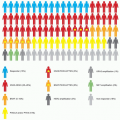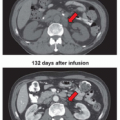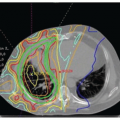United States.6 There are now more deaths from lung cancer in the United States than from the sum of colorectal, breast, and prostate cancers. Trends in lung cancer incidence and mortality have been nearly identical because there are few effective treatments for lung cancer, and survival time remains short. Lung cancer trends follow historic declines in tobacco use, lagged by about 20 years.13 Between 1965 and 1985, tobacco use among US adults dropped substantially, and more in men than in women. Lung cancer mortality rates began to decline among men in 1990, but rates increased among women throughout the 1990s. The stabilization of lung cancer incidence trends among women from 2000 to 2005 and the beginning of a decline in the period 2005 to 2010 foretells a coming persistent decline in lung cancer mortality among women in the United States.
TABLE 12.1 Trends in Risk Factors and Cancer Screening Practices in the United States, 1990-2010a | |||||||||||||||||||||||||||||||||||||||||||||||||||||||||||||||||||||||||||||||||||||||||||||||||||||||||||||||||||||||||||||||||||||||||||||||||||||||||||||||||||||||||||||||
|---|---|---|---|---|---|---|---|---|---|---|---|---|---|---|---|---|---|---|---|---|---|---|---|---|---|---|---|---|---|---|---|---|---|---|---|---|---|---|---|---|---|---|---|---|---|---|---|---|---|---|---|---|---|---|---|---|---|---|---|---|---|---|---|---|---|---|---|---|---|---|---|---|---|---|---|---|---|---|---|---|---|---|---|---|---|---|---|---|---|---|---|---|---|---|---|---|---|---|---|---|---|---|---|---|---|---|---|---|---|---|---|---|---|---|---|---|---|---|---|---|---|---|---|---|---|---|---|---|---|---|---|---|---|---|---|---|---|---|---|---|---|---|---|---|---|---|---|---|---|---|---|---|---|---|---|---|---|---|---|---|---|---|---|---|---|---|---|---|---|---|---|---|---|---|---|
| |||||||||||||||||||||||||||||||||||||||||||||||||||||||||||||||||||||||||||||||||||||||||||||||||||||||||||||||||||||||||||||||||||||||||||||||||||||||||||||||||||||||||||||||
Stay updated, free articles. Join our Telegram channel

Full access? Get Clinical Tree








